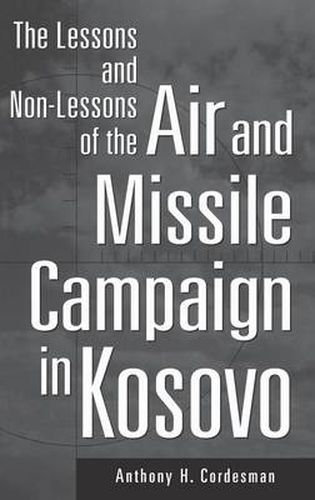Readings Newsletter
Become a Readings Member to make your shopping experience even easier.
Sign in or sign up for free!
You’re not far away from qualifying for FREE standard shipping within Australia
You’ve qualified for FREE standard shipping within Australia
The cart is loading…






The conclusion of a war typically signals the beginning of a flood of memoirs and instant campaign histories, many presenting the purported, but often dubious lessons of the recent conflict. Cordesman is careful to avoid such pitfalls in this detailed and closely reasoned analysis, and helps us to begin to understand the implications of this dramatic conflict on its own terms. Based on a combination of official and unofficial (but always authoritative) sources, he builds a thorough case for the true lessons of NATO’s first battle fought within Europe.
After consideration of the historical, major political, and strategic factors that set the stage for the Kosovo campaign, Cordesman critically examines the actual effectiveness of the NATO air campaigns, both in Kosovo and Serbia proper. Operations in this rugged part of Europe were difficult, and compounding the challenges of terrain and weather were the conflicting national agendas within the Allied coalition that seriously hampered focused and decisive action by NATO. Although Milosevic ultimately conceded defeat, all of these factors played an important role in limiting the intensity and shaping the military outcome of the campaign, and the likely political and strategic results were far from certain. Cordesman unflinchingly concludes, that the air campaign over Kosovo exposed deep fault lines within and among the NATO countries and fundamental flaws in the way the West wages war.
$9.00 standard shipping within Australia
FREE standard shipping within Australia for orders over $100.00
Express & International shipping calculated at checkout
The conclusion of a war typically signals the beginning of a flood of memoirs and instant campaign histories, many presenting the purported, but often dubious lessons of the recent conflict. Cordesman is careful to avoid such pitfalls in this detailed and closely reasoned analysis, and helps us to begin to understand the implications of this dramatic conflict on its own terms. Based on a combination of official and unofficial (but always authoritative) sources, he builds a thorough case for the true lessons of NATO’s first battle fought within Europe.
After consideration of the historical, major political, and strategic factors that set the stage for the Kosovo campaign, Cordesman critically examines the actual effectiveness of the NATO air campaigns, both in Kosovo and Serbia proper. Operations in this rugged part of Europe were difficult, and compounding the challenges of terrain and weather were the conflicting national agendas within the Allied coalition that seriously hampered focused and decisive action by NATO. Although Milosevic ultimately conceded defeat, all of these factors played an important role in limiting the intensity and shaping the military outcome of the campaign, and the likely political and strategic results were far from certain. Cordesman unflinchingly concludes, that the air campaign over Kosovo exposed deep fault lines within and among the NATO countries and fundamental flaws in the way the West wages war.